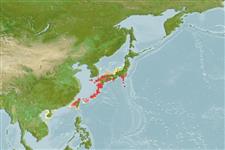Common names from other countries
>
Gobiiformes (Gobies) >
Gobiidae (Gobies) > Gobiinae
Etymology: Eviota: No etymology given, suggested by Christopher Scharpt: from Latin 'eu' for 'true' and 'iota' for anything very small, in combination 'truly very small' referring to it as being the smallest vertebrate at the time it has benn described by Jenkins (thus, making the suggestion by Scharpt plausible.; rubrimaculata: Name as an adjective from the Latin 'rubra' for red and 'macula' for spot; referring to the
distinctive red spots on the head and body..
Environment: milieu / climate zone / depth range / distribution range
Οικολογία
Θαλασσινό(ά) Υφαλόφιλο(α); εύρος βάθους 6 - 8 m (Ref. 104430). Subtropical
Κατανομή
Χώρες | Περιοχές FAO | Οικοσυστήματα | Παρουσίες | Point map | Εισαγωγές | Faunafri
Northwest Pacific: Ryukyu Is., Japan.
Μέγεθος / Βάρος / Age
Maturity: Lm ? range ? - ? cm
Max length : 1.2 cm SL (female)
Short description
Κλείδες προσδιορισμού | Μορφολογία | Μορφομετρία
Ραχιαίες άκανθες (συνολικά) : 7; Μαλακές ραχιαίες ακτίνες (συνολικά) : 9; Εδρικές άκανθες: 1; Μαλακές εδρικές ακτίνες: 8. This species is distinguished by the following characters: cephalic sensory-canal pore system pattern 2 (lacking only H [IT] pore); some pectoral-fin rays branched (11-15th rays); dorsal/anal fin-ray formula 9/8; absence of the 5th pelvic-fin ray; absence of the following - prominent distinct dark spots on pectoral-fin base, caudal-peduncle spot over preural centrum, postocular spots, and the strong and dark spots on caudal fin; anal-fin base with 2 dark spots; first dorsal fin clear with some light orange on anterodorsal portion and dark distal margin; second dorsal fin with red-orange spots on basal half, distal margin black and yellow; the body with bright red markings (Ref. 104430).
Life cycle and mating behavior
Maturities | Αναπαραγωγή | Spawnings | Egg(s) | Fecundities | Προνύμφες
Suzuki, T., D.W. Greenfield and H. Motomura, 2015. Two new dwarfgobies (Teleostei: Gobiidae) from the Ryukyu Islands, Japan: Eviota flavipinnata and Eviota rubrimaculata. Zootaxa 4007(3):399-408. (Ref. 104430)
IUCN Red List Status (Ref. 130435)
CITES (Ref. 128078)
Not Evaluated
Threat to humans
Harmless
Human uses
Εργαλεία
Special reports
Download XML
Διαδικτυακές πηγές
Estimates based on models
Phylogenetic diversity index (Ref.
82804): PD
50 = 0.5000 [Uniqueness, from 0.5 = low to 2.0 = high].
Bayesian length-weight: a=0.00708 (0.00333 - 0.01504), b=3.09 (2.92 - 3.26), in cm Total Length, based on LWR estimates for this (Sub)family-body shape (Ref.
93245).
Τροφικό Επίπεδο (Ref.
69278): 2.9 ±0.3 se; based on size and trophs of closest relatives
Ελαστικότητα (Ref.
120179): Υψηλό, ελάχιστος χρόνος για διπλασιασμό πληθυσμού < 15 μήνες (Preliminary K or Fecundity.).
Fishing Vulnerability (Ref.
59153): Low vulnerability (10 of 100).
